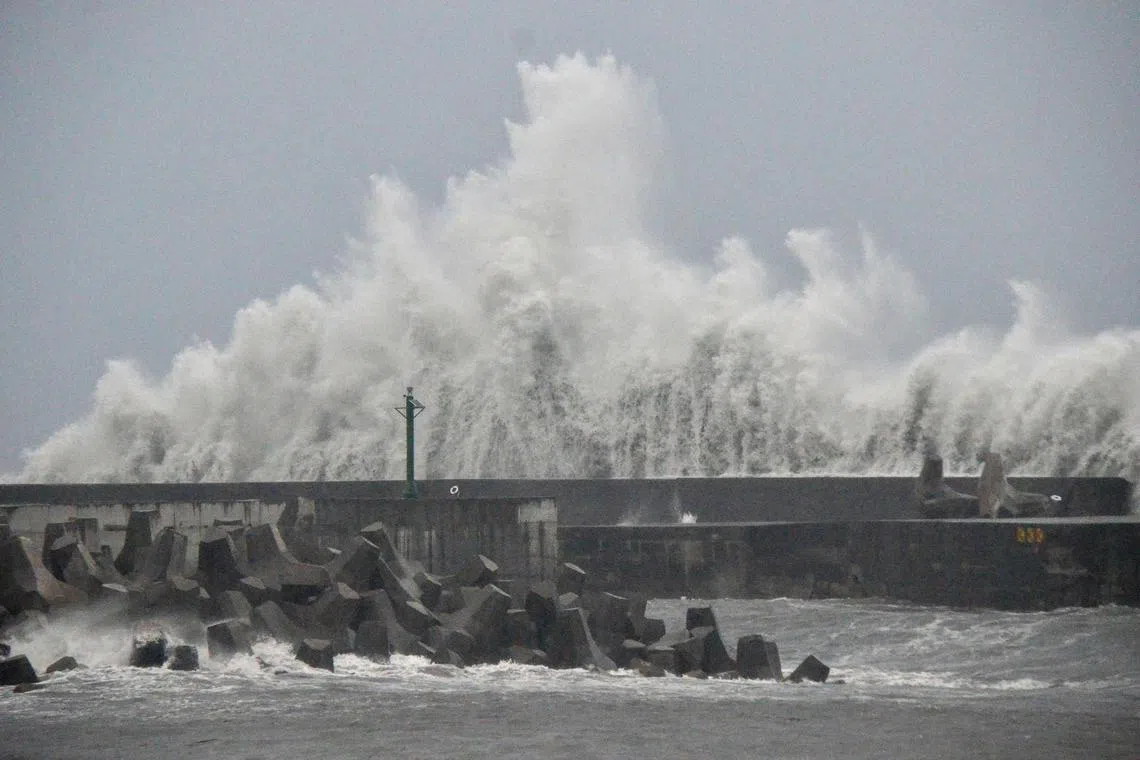Tropical storm Podul disrupts travel and schools in southern China
Sign up now: Get ST's newsletters delivered to your inbox

Typhoon Podul weakened from a typhoon to a tropical storm after making landfall in Taiwan on Aug 13.
PHOTO: AFP
Follow topic:
BEIJING – Tropical Storm Podul on Aug 14 dumped torrential rain on southern China, still reeling from record downpours last week, and disrupted hospitals, schools and courts in Hong Kong after tearing through Taiwan and leaving 143 people injured.
The hearing of Hong Kong media tycoon and pro-democracy advocate Jimmy Lai
Meanwhile, airports across the region reported cancellation rates for the morning of around 20 per cent, according to data from Flight Master, as the storm pelted parts of the Chinese provinces of Guangdong, Hunan and Jiangxi with more than 70mm of rain an hour.
Over a third of flights to Quanzhou – a key textile, footwear and apparel export hub – were cancelled, with analysts warning that extreme weather events increasingly pose a threat to growth in the world’s second-largest economy.
China has been battling with record rainfall in its north and south as well as prolonged heatwaves in its interior. The government on Aug 14 announced 430 million yuan (S$77 million) in fresh funding for disaster relief, taking the total allocated since April to at least 5.8 billion yuan.
“The authorities need to be extra ready,” said Mr Chim Lee, a senior analyst at the Economist Intelligence Unit. “There’s growing evidence that we’re seeing more intense and slower-moving tropical cyclones.
“China’s southern coast is set for economic disruptions of all kinds. Most institutions in the region are fairly well prepared, but there also seems to be a subtle northward shift in where cyclones reach their peak intensity – these places need to keep a sharper eye out.”
The storm made landfall on the coast of China’s south-eastern province of Fujian at 12.30am local time, having weakened from a typhoon to a tropical storm after lashing Taiwan on Aug 13, where winds of up to 191kmh left one person missing and scores injured.
“It’s been raining constantly, and raining really heavily,” said Ms Cara Liang, a 25-year-old visitor to Hong Kong from China’s neighbouring Guangdong province.
“Many places in mainland China have experienced flooding, which hasn’t been good for anyone. My trip to Hong Kong this time has been completely disrupted,” she told Reuters in the Asian financial centre’s business district.
But its residual vortex stands to wreak havoc in southern China, still reeling from the heaviest rain in generations last week, as it moves north-west at a speed of 30kmh to 35kmh.
Across Guangdong, 75,000 people were evacuated last week, as a record 622.6mm of rain fell on provincial capital Guangzhou from Aug 2 to 6 – almost three times the average rainfall for the city in August – killing at least seven people.
Hong Kong last week experienced its heaviest August rainfall since 1884 on Aug 5.
The authorities in Guangdong’s Meizhou city closed all highways on Aug 14 because of the downpour, state media outlets reported, while the high-speed railway linking the high-tech hubs of Shenzhen and Hangzhou in eastern Zhejiang province, some 1,200km away, was also suspended.
China, the world’s second-largest economy, faces growing threats from extreme weather, which meteorologists link to climate change. These risks each year stand to wipe out tens of billions of dollars worth of commercial activity, as cities flood, shipping activity stalls and croplands are washed out.
It will be a good day for the ducks, though, who will have the Hong Kong Wetland Park to themselves, as the park is closed for the time being. REUTERS

